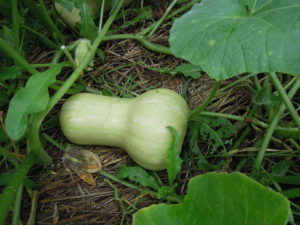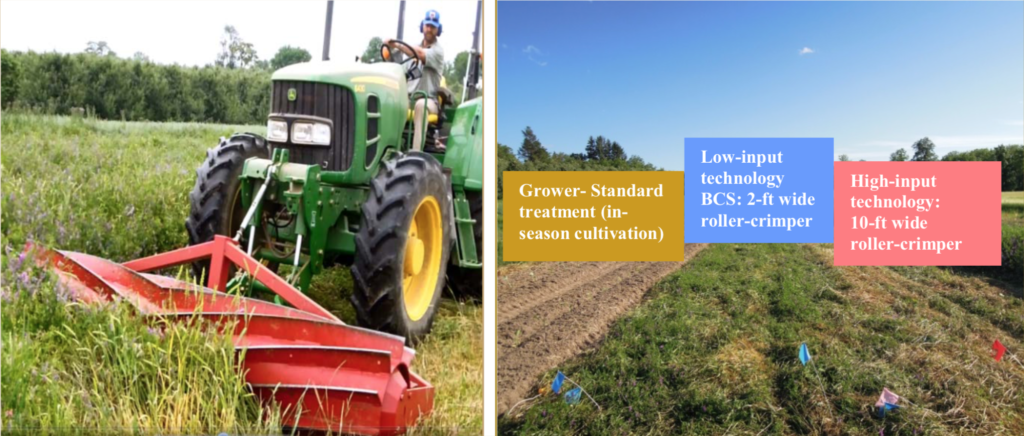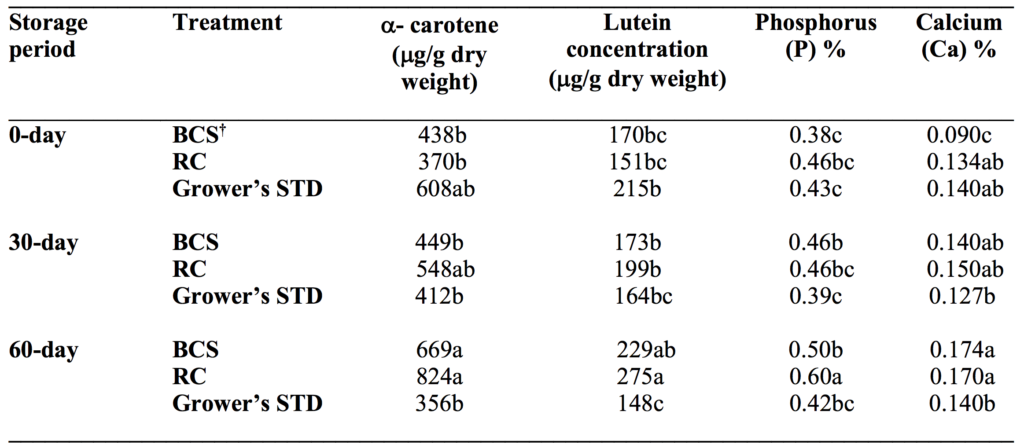Rodale Institute investigates the links between soil health and human health through our studies designed to analyze nutrient density in finished crops.
Overview
Winter squash,“Butternut types” (Cucurbita moschata Duch.), is grown on a vine and has yellow skin with orange fleshy pulp. ‘Waltham’, a popular variety of butternut squash, is valued for its nutritional quality and flesh color. Flesh color is considered an important quality attribute in winter squash for consumer acceptance of the product [1,2] as the orange color intensity is related to total carotenoid content, important phytonutrients [3]. Winter squash is a good nutritional source of minerals (potassium, phosphorus, calcium, magnesium, iron and selenium), vitamin C, E, K, vitamins B1, B2, and B6, dietary fiber, carotenoids, phenolic compounds (flavonoids and phenolic acids)[4,5].

Butternut squash is widely grown both in small and large farms in the United States using tilled management systems. In the United States one of the responses to soil degradation has been the promotion of soil conserving tillage practices known as reduced- or no-till agriculture. One of the methods for reducing tillage in organic agriculture is rolling and crimping of the cover crop to serve as residue mulch when growing vegetable crops (Photo 1). This practice eliminates multiple cultivations during the growing season, thus reducing fuel cost and degradation of soil health. While these benefits have been well established, there is a lack of information on the impact of reduced-tillage farming management on nutrient quality of post-harvest stored winter squash fruits.
John and Aimee Good (Quiet Creek Farm) are organic vegetable growers and grow a wide variety of vegetables on 10 acres in Kutztown, Pennsylvania. Their current system includes a Celli Spader to prepare beds and multiple in-season cultivations. The Goods were interested in testing and evaluating a range of equipment for reduced-tillage options when growing winter squash in order to make an informed decision on types of equipment they can invest in in order for them to transform their current farming system to a reduced-tillage system without impacting the nutrient quality of post-harvest stored winter squash.
To answer these questions, Rodale Institute partnered with the Goods in 2017 to demonstrate and evaluate the use of two reduced-tillage methods versus the grower standard method (in-season cultivation). The tilled system (Goods’ standard method) was compared side-by-side with two reduced-tillage methods: the first reduced-tillage practice was a low-input technology referred to as BCS, a 2-ft wide walk-behind roller-crimper accompanied by hand transplanting. The second practice was a high-input technology referred to as RC, a 10-ft wide roller-crimper driven by a tractor accompanied by no-till transplanter (Photo 2A). The overall goal of this demonstration was to provide the Goods and other growers with farming options that were deemed sustainable for conserving soil and improving fruit quality upon storage.
Demonstration Trials
In a demonstration trial at the Good Farm, a cover crop mixture of wheat, hairy vetch and crimson clover was established in September 2016. In spring 2017, the demonstration field was flagged for three treatments: a) Grower b) BCS and c) RC. The plot size of each treatment was 10 ft by 40 ft with four replications.
In plots that were designated as the grower’s treatment, the cover crop was first flail-mowed and the soil was spaded twice with the Celli Spader, forming two rows per plot on May 19, 2017. The cover crop in the reduced-tilled treatments was either rolled-crimped twice with a BCS, or with an RC on May 24 and June 1, 2017 (Photo 2B).

Seedlings of butternut squash, ‘Waltham,’ were transplanted into two-rows per plot with 24-inch spacing between plants using a water wheel transplanter for the standard treatment, hand planting for BCS, and utilizing a no-till transplanter for the RC treatment. The plants were rain-fed only. Hand-hoeing and two in-season cultivations were accomplished on June 22, and July 10, 2017. In the reduced-tillage treatments the weeds were only hand-weeded once.
At harvest, fruits were collected from 10 plants per treatment per replicate on August 29, 2017 and cured for two weeks. Whole fruit subsamples were taken and stored for 0, 30, and 60 days in a cool and dark room. At the end of each storage date, the skin of the fruits was peeled and cut (Photo 3), the fresh pulp was diced into cubes, placed in plastic bags, and was frozen at -20 degrees C.

Frozen samples were then freeze-dried, ground and stored immediately in dark amber jars to protect the ground samples from degradation by UV light. Subsamples were sent to Dr. Reddivari’s Laboratory at Purdue University for quantification of carotenoids (Lutein and α- carotene) and total polyphenols. For mineral quantification, another set of subsamples was sent to Pennsylvania State University’s Agricultural Analytical Services Laboratory (AASL). Although we have assessed total polyphenols, lutein, a-carotene, and several mineral nutrients (phosphorus (P), potassium (K), calcium (Ca), magnesium (Mg), iron (Fe), and manganese (Mn), in this web article, we are presenting summarized results on a-carotene and lutein (two antioxidants) and three minerals: P, Ca, and Fe only.
Mean concentration of α-carotene and lutein in winter squash fruit increased significantly in the reduced tillage (BCS and RC) treatments while in storage from 0-day to 60-days (Table 1). However, in the growers’ (in-season cultivation) standard treatment, mean concentrations of α-carotene and lutein in winter squash declined significantly after 60-days of storage. The decline was more pronounced in lutein than α-carotene. Mean P concentration in winter squash fruit increased significantly as storage period increased from 0 to 30 and 60 days in BCS and RC treatments when compared to standard treatment (Table 1). However, P concentration in the growers’ standard treatment did not change with storage time, averaging 0.41%, but was lower than those in reduced-tilled RC treatment. Mean Ca concentration in winter squash fruit increased significantly and almost doubled in the BCS treatment as the storage period increased to 60 days when compared to those in the growers’ standard treatment. Similarly, the Ca concentration in winter squash in the RC treatment increased from 0.13% to 0.17%, but the increase was not statistically significant as storage period increased to 60 days. Mean Ca concentration in winter squash fruit did not vary significantly in the growers’ standard treatment as the length of storage increased to 60 days, averaging 0.13%. The mean Fe concentration in winter squash did not vary significantly in the BCS and RC treatments as the storage period increased, ranging between 16 ppm and 22.5 ppm.
Findings
- Our results showed that the use of the low- and high-input technologies in reduced-tillage management enhanced nutrient concentration of α-carotene, lutein, calcium, and phosphorus in winter squash when stored for 60 days.
- Small-scale and large-scale vegetable growers alike can adopt reduced-tillage management systems to produce winter squash.
- Vegetable growers who have limited resources and capital may start by using the BCS with a roller-crimper, an affordable low-input technology, to terminate cover crops while producing high-quality winter squash.
- In addition to enhanced nutrient levels of winter squash when using the high-input technology method, growers will observe reductions in time used for using a tractor-driven roller-crimper to terminate the cover crop and transplanting as compared to those of the low-input technology system.
Table 1. Impact of management farming practices on mean concentration of α-carotene, lutein, phosphorus and calcium in butternut winter squash fruit when stored at 0, 30, and 60 days, Kutztown, Pennsylvania.

